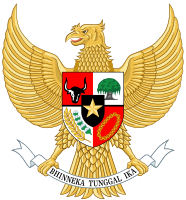
Wilopo was an Indonesian politician and lawyer. A capable administrator, he served as prime minister of Indonesia from 1952 to 1953. He also held various other positions during his career, including as Minister of Labor, Minister of Economic Affairs, speaker of the Constitutional Assembly, and chairman of the Supreme Advisory Council.
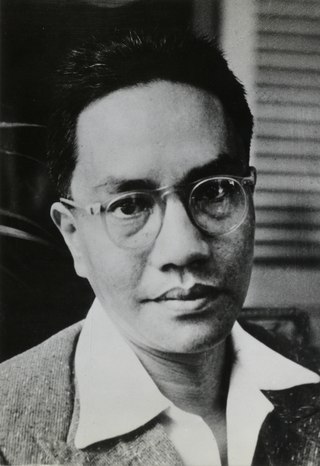
Amir Sjarifuddin Harahap was an Indonesian politician and journalist who served as the second prime minister of Indonesia from 1947 until 1948. A major leader of the left-wing during the Indonesian National Revolution, he previously served as Minister of Information from 1945 until 1946 and Minister of Defense from 1945 until 1948. Amir was born into the Sumatran aristocracy, and was educated at Leiden University. At Leiden, he became a member of the board of the Gymnasium student association in Haarlem, and was involved in the Batak student organization Jong Batak. He returned to Indonesia due to family troubles, but continued his education at the Rechts Hogeschool in Batavia.
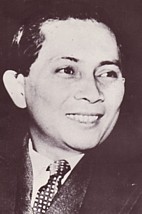
The position of Prime Minister of Indonesia existed from 1945 until 1966. During this period, the prime minister was in charge of the Cabinet of Indonesia, one of the three branches of government along with the People's Representative Council and the president. Following his 1959 decree, President Sukarno assumed the role and powers of prime minister until his resignation in 1966.

This is the timeline of Indonesian National Revolution.

The Liberal Democracy period in Indonesia, also known as the Era of Parliamentary Democracy, was a period in Indonesian political history, when the country was under a liberal democratic system. During this period, Indonesia held its first and only free and fair legislative election until 1999, but also saw continual political instability. The period began on 17 August 1950 following the dissolution of the federal United States of Indonesia, less than a year after its formation, and ended with the imposition of martial law and President Sukarno's decree, which resulted in the introduction of the Guided Democracy period on 5 July 1959.

Burhanuddin Harahap was an Indonesian politician and lawyer who served as prime minister of Indonesia from August 1955 until March 1956. He was a member of the Masyumi Party and served as Minister of Defense concurrently with his tenure as prime minister. Afterwards, he took part in the unsuccessful Revolutionary Government of the Republic of Indonesia (PRRI) rebellion in West Sumatra.

The Madiun Affair, known locally as the Communist Party of Indonesia rebellion of 1948, was an armed conflict between the government of the self-proclaimed Republic of Indonesia and the left-wing opposition group Front Demokrasi Rakyat during the Indonesian National Revolution. The conflict began on September 18, 1948, in Madiun, East Java, and ended three months later when most FDR leaders and members were detained and executed by TNI forces.

Sjafruddin Prawiranegara was an Indonesian statesman and economist. He served in various roles during his career, including as head of government in the Emergency Government of the Republic of Indonesia, as Minister of Finance in several cabinets, and as the first Governor of Bank Indonesia. Sjafruddin later became the prime minister of the Revolutionary Government of the Republic of Indonesia, a shadow government set up in opposition to the country's central government.

The Third Sjahrir Cabinet was the fourth Indonesian cabinet. It served from October 1946 to June 1947, when it fell due to disagreements related to the implementation of the Linggadjati Agreement and subsequent negotiations with the Dutch.

The First Amir Sjarifuddin Cabinet was the fifth Indonesian cabinet and was in office from 3 July to 11 November 1947.

The Second Amir Sjarifuddin Cabinet was Indonesia's sixth cabinet and was the result of a reshuffle to allow for the entry of the Masyumi Party, which gained five posts. The cabinet lasted only two months and eleven days, from 11 November 1947 to 23 January 1948, after Masyumi withdrew its ministers in protest at the Renville Agreement the government signed with the Dutch.

Sjafruddin Prawiranegara's Emergency Cabinet was the government of the Emergency Government of the Republic of Indonesia (PDRI), effectively Indonesia's government in exile, established in Bukittinggi, West Sumatra following the second Dutch military aggression when the republican capital of Yogyakarta was seized and most of the cabinet allowed itself to be captured in the hope of attracting sympathy from the outside world.

The Second Hatta Cabinet was Indonesia's ninth cabinet. It was formed after the Indonesian leadership, which had been imprisoned by Dutch forces, returned to the capital, Yogyakarta. It served from 4 August to 14 December 1949.

Soekiman Wirjosandjojo was an Indonesian politician and physician who served as prime minister of Indonesia from 1951 until 1952. Additionally, Soekiman served as the first president of the Masyumi Party from 1945 to 1951.

The Natsir Cabinet was the first cabinet formed after the dissolution of the United Republic of Indonesia and returned to the Unitary State of the Republic of Indonesia. This cabinet was in charge from 6 September 1950 until 20 March 1951.
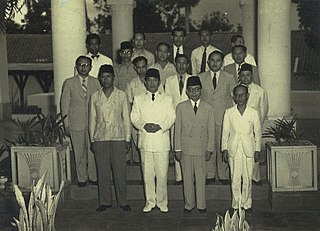
The Soekiman Cabinet, also known as the Sukiman-Suwirjo Cabinet, was an Indonesian cabinet that served from 27 April 1951 until 25 February 1952, when it fell following revelations that it had signed a mutual security agreement with the United States.

The Wilopo Cabinet, also known as the Wilopo-Prawoto Cabinet, was an Indonesian cabinet that served from 1 April 1952 until 3 June 1953.

Adnan Kapau Gani, often abbreviated as A. K. Gani, was an Indonesian politician. Born in West Sumatra, he spent much of his youth in Java, where he studied medicine and became involved with the nascent nationalist movement before going to South Sumatra to work as a doctor. During the Indonesian National Revolution he served three terms as Minister of Welfare; two of these were concurrent with terms as a deputy prime minister. Afterwards Gani went to Palembang, South Sumatra, where he remained active in politics until his death. In November 2007 Gani was made a National Hero of Indonesia.
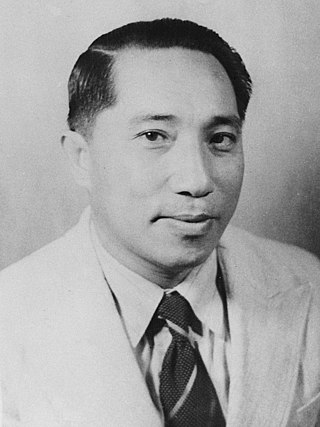
Herling Laoh was an Indonesian bureaucrat and engineer. A member of the Indonesian National Party (PNI), Laoh served as minister of public works (1947–1950) and minister of transportation (1949–1950). Born to a goldsmith and his wife in present-day North Sulawesi, he studied civil engineering at the Technische Hoogeschool te Bandoeng (THB). After graduating in 1928, he worked as an engineer in various construction projects. Following the Proclamation of Indonesian Independence in 1945, he joined the PNI and served as a minister in several cabinets. He was later involved in PRRI/Permesta rebellion, becoming a state minister in the rebel government.

Prawoto Mangkusasmito was an Indonesian politician who served as the final chairman of the Masyumi political party prior to its dissolution in 1960. He also served as the Deputy Prime Minister of Indonesia during the Wilopo Cabinet between 1952 and 1953.
